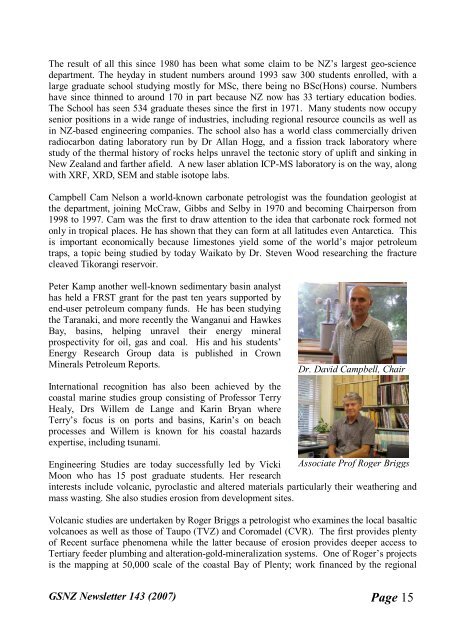Links - Geoscience Society of New Zealand
Links - Geoscience Society of New Zealand
Links - Geoscience Society of New Zealand
You also want an ePaper? Increase the reach of your titles
YUMPU automatically turns print PDFs into web optimized ePapers that Google loves.
The result <strong>of</strong> all this since 1980 has been what some claim to be NZ’s largest geo-science<br />
department. The heyday in student numbers around 1993 saw 300 students enrolled, with a<br />
large graduate school studying mostly for MSc, there being no BSc(Hons) course. Numbers<br />
have since thinned to around 170 in part because NZ now has 33 tertiary education bodies.<br />
The School has seen 534 graduate theses since the first in 1971. Many students now occupy<br />
senior positions in a wide range <strong>of</strong> industries, including regional resource councils as well as<br />
in NZ-based engineering companies. The school also has a world class commercially driven<br />
radiocarbon dating laboratory run by Dr Allan Hogg, and a fission track laboratory where<br />
study <strong>of</strong> the thermal history <strong>of</strong> rocks helps unravel the tectonic story <strong>of</strong> uplift and sinking in<br />
<strong>New</strong> <strong>Zealand</strong> and farther afield. A new laser ablation ICP-MS laboratory is on the way, along<br />
with XRF, XRD, SEM and stable isotope labs.<br />
Campbell Cam Nelson a world-known carbonate petrologist was the foundation geologist at<br />
the department, joining McCraw, Gibbs and Selby in 1970 and becoming Chairperson from<br />
1998 to 1997. Cam was the first to draw attention to the idea that carbonate rock formed not<br />
only in tropical places. He has shown that they can form at all latitudes even Antarctica. This<br />
is important economically because limestones yield some <strong>of</strong> the world’s major petroleum<br />
traps, a topic being studied by today Waikato by Dr. Steven Wood researching the fracture<br />
cleaved Tikorangi reservoir.<br />
Peter Kamp another well-known sedimentary basin analyst<br />
has held a FRST grant for the past ten years supported by<br />
end-user petroleum company funds. He has been studying<br />
the Taranaki, and more recently the Wanganui and Hawkes<br />
Bay, basins, helping unravel their energy mineral<br />
prospectivity for oil, gas and coal. His and his students’<br />
Energy Research Group data is published in Crown<br />
Minerals Petroleum Reports.<br />
International recognition has also been achieved by the<br />
coastal marine studies group consisting <strong>of</strong> Pr<strong>of</strong>essor Terry<br />
Healy, Drs Willem de Lange and Karin Bryan where<br />
Terry’s focus is on ports and basins, Karin’s on beach<br />
processes and Willem is known for his coastal hazards<br />
expertise, including tsunami.<br />
Dr. David Campbell, Chair<br />
Engineering Studies are today successfully led by Vicki Associate Pr<strong>of</strong> Roger Briggs<br />
Moon who has 15 post graduate students. Her research<br />
interests include volcanic, pyroclastic and altered materials particularly their weathering and<br />
mass wasting. She also studies erosion from development sites.<br />
Volcanic studies are undertaken by Roger Briggs a petrologist who examines the local basaltic<br />
volcanoes as well as those <strong>of</strong> Taupo (TVZ) and Coromadel (CVR). The first provides plenty<br />
<strong>of</strong> Recent surface phenomena while the latter because <strong>of</strong> erosion provides deeper access to<br />
Tertiary feeder plumbing and alteration-gold-mineralization systems. One <strong>of</strong> Roger’s projects<br />
is the mapping at 50,000 scale <strong>of</strong> the coastal Bay <strong>of</strong> Plenty; work financed by the regional<br />
GSNZ <strong>New</strong>sletter 143 (2007) Page 15















